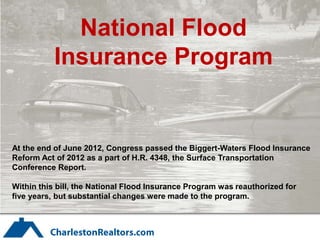
National Flood Insurance Program - 2012-13 Update
- 1. National Flood Insurance Program At the end of June 2012, Congress passed the Biggert-Waters Flood Insurance Reform Act of 2012 as a part of H.R. 4348, the Surface Transportation Conference Report. Within this bill, the National Flood Insurance Program was reauthorized for five years, but substantial changes were made to the program.
- 2. National Flood Insurance Program ISSUE: Congress reauthorized the National Flood Insurance Program (NFIP) for 5 years ensuring properties will have available, affordable protection. WHAT WAS THE PROBLEM WITH NFIP? 80% of properties covered by the NFIP are already paying full actuarial rates, but 20% of were paying subsidized rates. Prior to passage of the bill, it was estimated by the Congressional Budget Office that subsidized properties were only paying 40% of their true actuarial risk. With the NFIP $18 billion in debt and federal deficits at an all time high – subsidies of any kind were on the chopping block Ongoing taxpayer subsidies first enacted in 1975 meant two houses on the same block with the same value and risk could be paying different insurance rates
- 3. National Flood Insurance Program WHAT THE REAUTHORIZATION DOES: Solves the Wind v. Water issue – establishes a formula for NFIP and wind insurers to pay where property damage cannot be attributed to wind or water, settling a long-standing dispute and avoiding further lawsuits Clarifies that the aggregate coverage limit is $250,000 for each 1-4 unit multifamily building, and $500,000 for each business structure and $500,000 for the contents. Improves the accuracy of floodplain maps by establishing a technical council of experts to review and set the standards Establishes an independent appeals board for homeowners and communities to resolve their flood map disputes with FEMA Reimburses homeowner’s appeal expenses when successfully challenging a flood map Clarifies that multi-family property owners with 5 or more units are eligible for up to $500,000 in structural coverage under the NFIP, the same as a business property. This does not preclude individuals residing in those properties from buying their own NFIP contents coverage. Clarifies that the aggregate coverage limit is $250,000 for each 1-4 unit multifamily building, and $500,000 for each business structure and $500,000 for the contents.
- 4. National Flood Insurance Program WHO IS GOING TO SEE A RATE INCREASE: IF YOU HAVE ANY TYPE OF PROPERTY – PRIMARY OR SECOND HOME THAT IS NOT PRE- 1975 (i.e. NOT SUBSIDIZED, which is 80% of all properties with flood insurance) You will most likely see nominal rate changes similar to before the legislation IF YOU HAVE A SECOND HOME, BUSINESS, OR REPETITIVE LOSS PROPERTY BUILT BEFORE 1975 THAT WAS STILL RECEIVING A SUBSIDY: Your premium will increase by no more than 25% a year over 4 years until you are paying “full actuarial rates” IF YOU HAVE A PRIMARY RESIDENCE THAT WAS BUILT BEFORE 1975 THAT WAS STILL RECEIVING A SUBSIDY: Your premium will increase by no more than 20% a year over 5 years until you are paying “full actuarial rates” IF YOU ARE NEWLY MAPPED INTO A FLOOD PLAIN: The initial rate for any property newly mapped or updated/revised into a mandatory purchase area would be subsidized (50 percent of actuarial) but then increase by 20 percent per year thereafter, until premiums reach the full (actuarial) cost.
- 5. Questions? Ryan Castle Government Affairs Director Charleston Trident Association of REALTORS Ryan@CharlestonRealtors.com 843.793.5212 @ryanfcastle www.ryanfcastle.com
